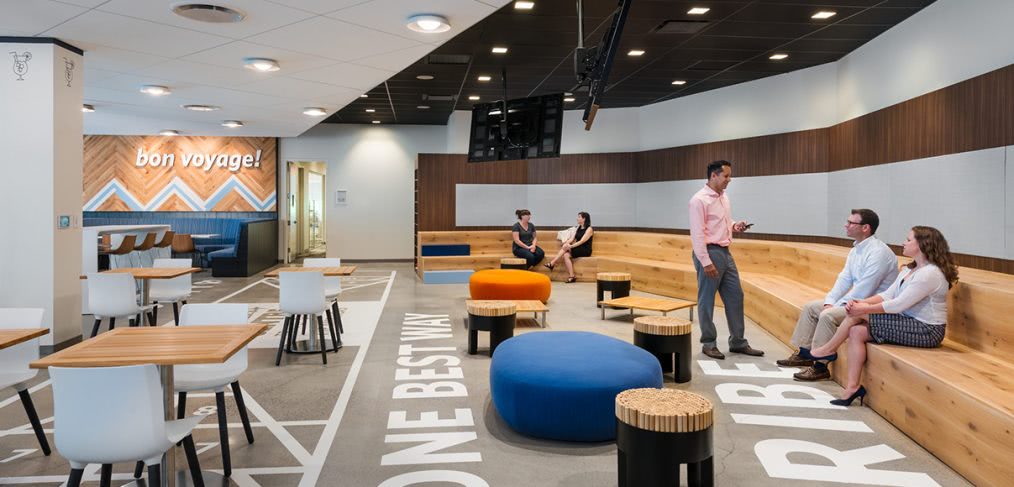
All Work and No Play: Designing for Passion in the Workplace
Associate Bonnie Toland discusses how to design for passion and productivity.
As a child, my mother would tell me, “Finish your work first, then you can play.” The idea that work is a task to complete before life can happen has colored my academic and professional life. It’s a widespread concept that cripples creativity and drains the joy from work by severing the connection between passion and productivity. As we design for the workplace, we begin to question the concept of work, as well as our attitudes and beliefs about it. To continue to evolve workplace design, we must return to the core of our practice, with a willingness to examine, challenge, redefine and broaden our perceptions of work.
While there is general consensus that the most successful people love what they do, it’s easy to fall into the trap of designing for single-purpose, machine-like employees. I have had clients who monitor employee trips to the restroom because they see it as lost productivity. I have had clients who are more concerned about maintaining their hierarchy than elevating their people.
Conscious or unconscious, our perceptions of work impact how we conceive the spaces meant to support it. If we intentionally define work in a new way, then the manner in which we create work spaces will also shift. This goes beyond defining the physical needs of the workplace in terms of collaboration, privacy, storage, desking, and daylight; it means changing our engrained beliefs of what it means to work and our emotional responses to it.
“Rule number one: have fun,” an interviewer early in my career once told me. Work can and should bring us joy. But, it is often a source of anxiety—a space where we define ourselves by title or accomplishment, which can pit employees against each other instead of encouraging them to work towards a common vision. When people come to work in fear, there is reason for concern. Of course, design cannot solve all workplace dynamics, but it can lay the groundwork for promoting harmony and ease.
People’s lives are not compartmentalized. We don’t leave pieces of ourselves at the door—and that’s a good thing. Design shouldn’t be compartmentalized either. One of the advantages of a large architecture firm is the opportunity to learn and work across sectors and disciplines. Initially, it may seem inefficient, but the richness added is well worth the time invested.
When sectors work together, their expertise can converge to produce holistic nurturing spaces. Common examples include the infusion of hospitality concepts into healthcare design and residential concepts into the workplace.
CallisonRTKL is particularly well positioned to infuse its retail design experience into the workplace. Concepts such as physical interpretation of identity and emotional connection to brand, as well as special attention to the user journey, could be applied to enhance the work experience. Retail designers are masters at maximizing every moment and every square inch of space, because retail clients are highly aware of the value of their real estate and its link to their profits. As the way people work evolves, companies are shifting their understanding of their assets, both in terms of real estate and in terms of staff. Although function still takes center stage, more attention is being placed on how a space communicates a company’s values and embraces employees into its community. The user journey, which retail designers consider with great attention, is becoming increasingly relevant in workplace as focus moves to the interstitial spaces and the overall worker experience, and the office moves away from being a place to accomplish tasks.
Student union design provides unique opportunities and challenges because of the needed student buy-in. If students are not convinced of the importance of a new union, they can vote down the student fee increase. Student involvement in the design process is essential for a project to move forward. While working on student unions, many design teams have organized activities that invite students to participate in the visioning for their new unions. Students could take part in activities such as tours of other student unions, the development of a common vocabulary to critique design, prioritization exercises to create visual references of the student body’s wants and needs, anonymous interviews about the current student union and more. These events help the design team imagine a student union that truly reflects the students it intends to serve.
Dynamics in different sectors may make this type of engagement challenging, but similar activities could successfully be included in workplace design under the right circumstances and with the right client. This goes far beyond the standard programming questionnaire and could potentially revolutionize how workplace is conceived.
For the practical need of specialization in functional aspects of complex spaces, sectors progressively isolate themselves. Although this is completely understandable, designers and end-users stand to benefit greatly from cross-sector problem solving. The opportunity to draw on lessons learned across sectors can lead to innovative, humane and inspiring spaces if design firms encourage the healthy cross-pollination of ideas and resist the urge to silo the sectors.
Work is what most of us do, most of the day, most of the week, for most of the year. It is the core of our lives in terms of time and energy commitment. Yet, many people hold deep seated beliefs about work as something isolated from the rest of life. If we intend to elevate and innovate in workplace design, we, as designers and workers, need to become aware of and challenge our own beliefs about work. We can immediately broaden our approach to workplace design by bringing in cross-sector knowledge to design more holistic spaces that nurture a fuller human experience.

Howdy! I just want to give an enormous thumbs up for the good info you’ve right here on this post. I might be coming back to your weblog for more soon.